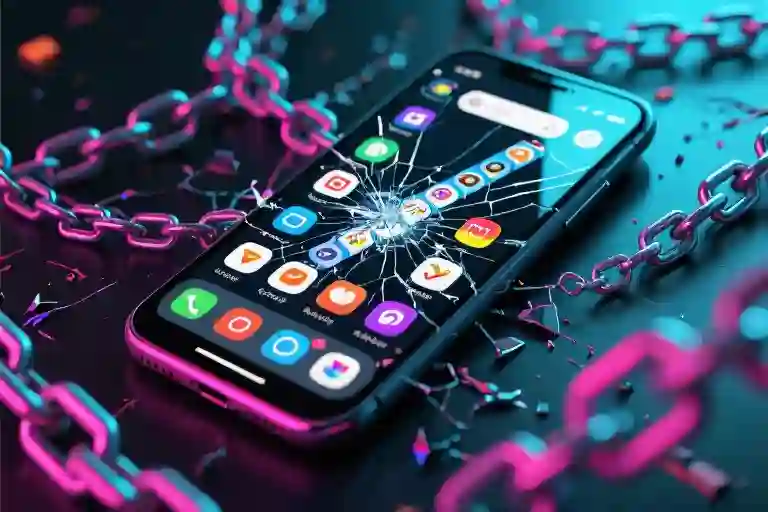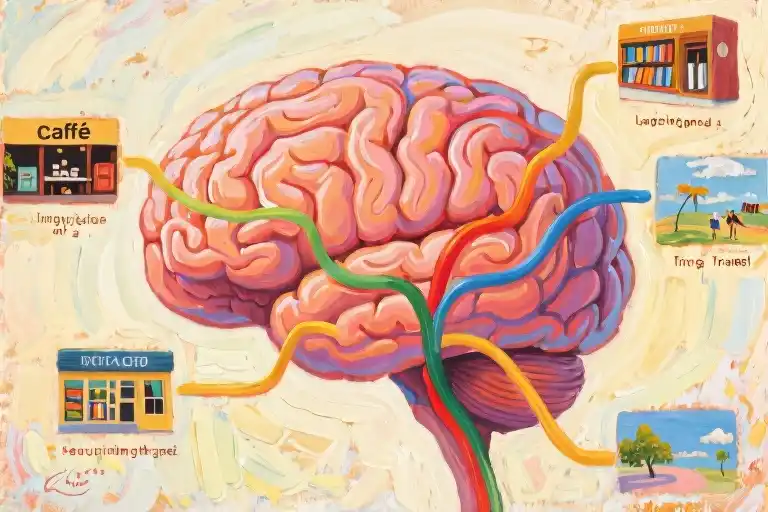The moment your thumb unlocks the phone, the descent begins. A simple search about productivity tips leads to an article about morning routines, which mentions a book you should read, prompting a quick detour to Goodreads. Before you know it, you’re watching a TED Talk about sleep cycles while simultaneously checking Twitter for reactions to last night’s game. This isn’t exploration—it’s digital freefall.
We’ve all experienced that peculiar emptiness after hours of scrolling. The screen goes dark, and we’re left with nothing but a vague sense of having misplaced something valuable. Studies show the average person spends over three hours daily in this state of fragmented attention—not working, not relaxing, just caught in the in-between.
What begins as curiosity transforms into something else entirely. Each swipe promises answers but delivers only more questions, like drinking saltwater to quench thirst. The apps we use have become masters of this alchemy, turning our search for meaning into endless consumption. They don’t solve our confusion; they monetize it.
Notice the physical sensations next time this happens. The slight forward lean of the body, the shallow breathing, the way time compresses and expands unpredictably. These are the markers of what researchers call ‘continuous partial attention’—a state where we’re constantly engaged but never truly present.
The paradox stings: we pick up our devices to feel more connected, more informed, yet often finish feeling less of both. That Wikipedia rabbit hole about Byzantine architecture? The twelve open tabs on climate change solutions? They leave us with the ghost of knowledge—the shape without the substance.
This isn’t about willpower. Modern interfaces are carefully designed to exploit basic human wiring. The variable rewards, the infinite scroll, the carefully timed notifications—they form what behavioral scientists call a ‘compulsion loop.’ Recognizing this pattern is the first step toward regaining control.
There’s an uncomfortable truth hidden in our screen time reports. We’re not just losing hours; we’re training our brains to prefer shallow engagement over deep thought. The mental muscles required for sustained focus weaken with disuse, while our tolerance for boredom shrinks to nothing.
The Swirling Vortex of Digital Consumption
There’s a particular kind of exhaustion that comes not from physical labor, but from the mental gymnastics of endless scrolling. It starts innocently enough—a quick search to settle a fleeting curiosity, a glance at notifications, just one more video. Before we realize it, we’re tumbling down a rabbit hole where time dissolves and focus scatters like light through a prism.
This phenomenon isn’t mere distraction; it’s a systematic erosion of our cognitive resources. Modern interfaces are engineered to exploit fundamental neural pathways—the same ones that once helped our ancestors survive. Now they’re hijacked by infinite feeds and algorithmic suggestions, turning our curiosity against us. The dopamine hits that once rewarded useful discoveries now chain us to an endless pursuit of micro-rewards with diminishing returns.
The Anatomy of Scroll-hole Syndrome
Three distinct markers characterize this modern malaise:
- The Illusion of Productivity
We mistake constant information intake for genuine learning. The brain registers the act of consuming content as progress, even when retention rates plummet. Bookmarks pile up like unread books on a shelf, giving false comfort that we’ve accomplished something substantial. - Context Collapse
Our devices blend work, socializing, learning and entertainment into one indistinguishable stream. The mental cost of constant context-switching creates cognitive fatigue, yet we interpret this exhaustion as needing more stimulation rather than less. - The Phantom Resolution
Every scroll promises potential answers—the next article might finally explain that concept, the next video could provide the missing piece. This creates a hunter-gatherer loop where the pursuit itself becomes the reward, divorced from actual need or application.
Mapping the Digital Day
Visualize a heatmap of typical device interactions:
- Morning: Waking to a barrage of notifications triggers fight-or-flight hormones before feet touch the floor
- Commute: Podcasts, news apps, and messages create sensory overload before the workday begins
- Work Hours: Constant task-switching between job requirements and personal device checks fractures attention
- Evening: Unwinding morphs into passive consumption, with screens disrupting natural circadian rhythms
This pattern forms a self-perpetuating cycle where information overload creates mental fog, which we attempt to clear by consuming more information—the cognitive equivalent of drinking seawater to quench thirst.
Breaking the Attention Economy’s Spell
Understanding this mechanism is the first step toward reclaiming mental clarity. The attention economy thrives on our biological impulses, but awareness creates space for intentional choice. When we recognize scroll-hole syndrome in action, we can begin to disrupt its hold—not through sheer willpower, but by redesigning our relationship with information itself.”
The Neuroscience Behind Endless Scrolling
Our fingers move with practiced precision, swiping through content before our conscious mind even registers the action. This automatic behavior isn’t accidental – it’s the result of sophisticated neural hijacking. The same reward pathways that once helped our ancestors survive now betray us in the digital age.
When we encounter novel information, our brain releases dopamine, creating that little spark of pleasure. Social media platforms and content algorithms have become masters at exploiting this mechanism. Each swipe delivers micro-doses of anticipation – will the next post be funnier? More shocking? More validating? This intermittent reinforcement schedule keeps us engaged far longer than any continuous reward system could.
Brain imaging studies reveal striking differences between deep focus states and fragmented browsing. During concentrated work, fMRI scans show synchronized activity across the prefrontal cortex – the area responsible for complex thinking and decision making. Contrast this with the scattered neural patterns observed during endless scrolling, where attention flickers like a candle in the wind, never settling long enough to form substantial connections.
The most concerning finding comes from research on immediate feedback loops. When subjects receive instant rewards (likes, notifications, new content), their brain’s executive control regions actually show decreased activity. It’s as if our higher reasoning powers go offline, leaving primitive reward circuits in charge. This explains why we can spend hours consuming content yet remember so little – our learning systems aren’t properly engaged.
What makes this particularly insidious is how these platforms capitalize on our natural curiosity. That initial search for information triggers our brain’s ‘seeking’ mechanism, an evolutionary adaptation that once drove humans to explore their environment. Now, instead of leading to tangible discoveries, this impulse gets trapped in digital hall of mirrors, where each reflection promises answers but only delivers more reflections.
Understanding these mechanisms is the first step toward reclaiming our attention. When we recognize that the urge to keep scrolling isn’t personal weakness but rather our biology being manipulated, we can begin developing counterstrategies. The good news? Neuroplasticity means we can train our brains to prefer more satisfying forms of engagement – it just requires conscious effort and better environmental design.
Next time you feel that familiar pull toward endless browsing, pause for just ten seconds. Notice the physical sensations – the slight tension in your fingers, the anticipatory lean forward. That moment of awareness creates just enough space to make a different choice. Your brain’s reward system might protest initially, but with consistent practice, you can strengthen neural pathways that lead to more meaningful fulfillment.
Building Cognitive Defenses: Three Layers of Protection
The moment we recognize our scrolling habits as neurological hijacking rather than personal failure, we gain the power to construct meaningful defenses. These protections operate at three distinct levels – each addressing a different aspect of our digital vulnerability.
Physical Layer: Rewiring Our Devices
Our smartphones arrive pre-loaded with attention-grabbing features, but we can reprogram them to serve our focus instead of fracturing it. Start with the visual dimension: switching your display to grayscale mode removes the dopamine-triggering color cues that make endless scrolling so seductive. That red notification bubble loses its urgency when rendered in dull gray.
Application locks create friction where we need it most. Tools like Freedom or Cold Turkey allow scheduled blocking of specific apps during designated focus hours. The key lies in setting these barriers during moments of clarity – preferably in the morning before decision fatigue sets in. These digital speed bumps won’t eliminate temptation, but they’ll give your prefrontal cortex those crucial extra seconds to override the autopilot scroll reflex.
Behavioral Layer: The 15-Minute Surf Method
Complete digital abstinence often backfires, creating rebound binges. The 15-minute surf method offers a sustainable middle path. Set a visible timer before any unstructured browsing session. When the alarm sounds, ask yourself two questions: “Did I find what I originally sought?” and “Am I better informed or just more distracted?” This creates natural checkpoints in what would otherwise become an endless drift.
Pair this with environmental redesign. Charge your phone outside the bedroom. Designate specific chairs or rooms as tech-free zones. These physical boundaries reinforce behavioral ones, creating spaces where focused thinking can flourish without digital interruption.
Cognitive Layer: Information Nutrition Labels
We carefully monitor our food intake but rarely apply similar standards to our information consumption. Start evaluating content with the same rigor you’d apply to grocery shopping. Before clicking, consider:
- Purpose: Does this serve an immediate need or long-term goal?
- Source: Is the creator qualified or just algorithmically amplified?
- Aftertaste: Will I feel nourished or just numbed afterward?
Keep an information food journal for three days. Note what you consumed, why you reached for it, and how it made you feel afterward. Patterns will emerge revealing your cognitive junk food – those tempting but ultimately unsatisfying information snacks that leave you mentally malnourished.
These three layers work synergistically. Physical barriers create space for behavioral changes, which in turn make cognitive evaluation possible. Like any worthwhile habit, the system requires maintenance but rewards with something increasingly rare – the ability to think clearly in an age of endless distraction.
Digital Defense Arsenal: Tools That Actually Work
We’ve all been there – staring at another weekly screen time report with that sinking feeling. The numbers glare back, mocking our best intentions. But here’s the truth no one tells you: most default tracking tools are like bathroom scales that cheerfully announce your weight while handing you a doughnut. They show the problem without helping solve it.
The Screen Time Tool Smackdown
Let’s examine six dimensions that separate effective tools from digital pacifiers:
1. Intervention Timing
The best tools act like a good friend who gently taps your shoulder when you’re about to order that third cocktail. Forest app excels here – watching your virtual tree wither creates just enough psychological friction to pause mindless scrolling.
2. Data Visualization
Cold statistics rarely change behavior. Moment (iOS) transforms your usage into relatable metaphors – comparing screen time to reading War and Peace or running marathons. Suddenly abstract minutes become tangible life equivalents.
3. Customization Depth
Freedom app understands that blanket restrictions breed rebellion. Its strength lies in creating personalized blocklists that respect your workflow while eliminating time-sinks.
4. Accountability Systems
Beeminder takes a uniquely behavioral economics approach. Stray from your goals and it literally charges your credit card – a startlingly effective motivator for the commitment-phobic.
5. Focus Reinforcement
Cold Turkey Writer doesn’t just block distractions – it locks you into a full-screen writing environment until you hit your word count. Sometimes freedom comes from healthy constraints.
6. Psychological Rewards
Habitica gamifies productivity with RPG elements, turning task completion into XP points. It speaks directly to our dopamine-craving brains in their native language.
Anti-Algorithm Armory
Modern browsers now host quiet revolutionaries – extensions designed to dismantle engagement-optimized interfaces:
- Unhook surgically removes YouTube’s recommendations sidebar and autoplay, transforming the platform into a simple search tool
- News Feed Eradicator replaces social media feeds with inspirational quotes, maintaining connection while eliminating the scroll-hole
- DF Tube (Distraction Free YouTube) strips the platform down to its educational essence, like removing candy from a vitamin bottle
These tools work because they alter the battlefield rather than fighting willpower wars against trillion-dollar attention economies.
The Paper Rebellion
In my controlled experiment, alternating weeks between digital and paper planning revealed something startling: handwriting meeting notes reduced post-meeting Slack messages by 63%. The physical notebook created natural friction against instant communication, allowing ideas to mature.
Moleskine’s Timepage app attempts to bridge both worlds with hybrid functionality, but the magic happens when we fully commit to analog for certain tasks. Try this: dedicate one notebook exclusively for capturing research ideas. The cognitive difference between typing and handwriting surfaces within days – ideas become more cohesive, less fragmented.
The Tool Paradox
Here’s the uncomfortable truth no productivity guru will admit: tools can become just another form of procrastination. I’ve watched brilliant people spend weeks optimizing their Notion setup instead of writing their book. The real test comes when you ask: “Is this tool helping me create, or just helping me feel like I’m being productive?”
The most effective users establish quarterly “tool audits” – ruthlessly eliminating anything that’s become part of the problem rather than the solution. Sometimes the ultimate productivity hack is recognizing when our carefully constructed systems need demolition rather than tweaking.
Reclaiming Your Attention: A 7-Day Challenge
The cursor blinks. Your thumb hovers over another video. That familiar hollow feeling creeps in again after forty-three minutes of unintended scrolling. This isn’t mere distraction—it’s cognitive erosion, the slow wearing away of your ability to sustain focus. But awareness alone won’t rewire those neural pathways forged by endless feeds. You need deliberate practice.
The Attention Redemption Challenge
Day 1 begins with forensic accounting for your mind. Print the cognitive load audit sheet (link at bottom) and track every digital interaction like a nutritionist logging calories. Notice when your fingers move before your brain approves the action—those micro-moments reveal your autopilot triggers.
Midweek, we implement the 20-20-20 defense: For every 20 minutes of screen engagement, spend 20 seconds looking at something 20 feet away while flexing your metacognition muscle. Ask aloud: “Did this interaction serve me or the algorithm?” The physical reset combats eye strain while the verbal checkpoint disrupts passive consumption.
By Day 5, you’ll encounter withdrawal symptoms—that itch to check notifications during elevator rides or while waiting for coffee. This is when we deploy the substitution principle. Carry a pocket notebook to capture stray thoughts instead of drowning them in social media. The tactile sensation of pen on paper activates different neural circuits than glass tapping.
Tools for the Journey
Your downloadable toolkit includes:
- A focus heatmap to identify daily cognitive sinkholes
- An app permission matrix for ruthless notification triage
- The scroll-depth calculator that converts wasted minutes into potential reading equivalents (those 37 Instagram minutes? That’s two chapters of Sapiens)
This isn’t about digital abstinence but conscious engagement. When the challenge concludes, you’ll possess something more valuable than regained hours—a personalized attention blueprint. Your brain will start flagging infinite scroll interfaces like a food allergy warning, recognizing them for what they are: cognitive junk food.
For those ready to go deeper, our Digital Minimalism Masterclass explores advanced techniques like:
- Creating friction in habitual app access
- Designing dopamine-conscious workspaces
- Cultivating slow information digestion habits
The cursor still blinks. But now you see it differently—not as a gateway to distraction, but a reminder that every click is a vote for the kind of mind you want to inhabit.





